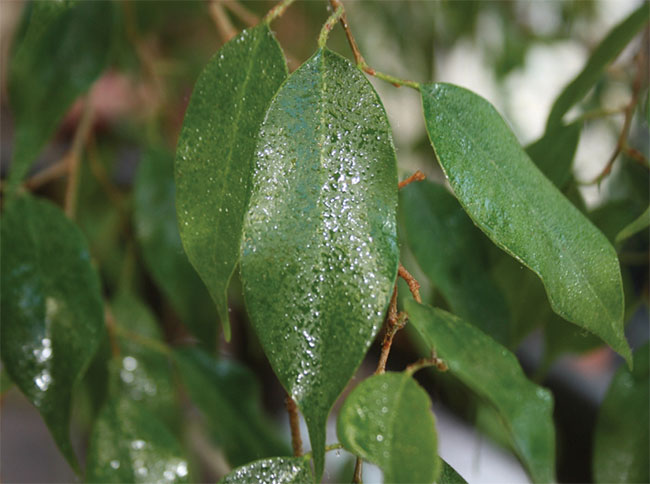
Dr. Bugs — Insect and Mite Pests Feeding Behaviors and Plant Damage
Answer: The two major feeding behaviors of insect and mite pests of greenhouse-grown horticultural crops are chewing and piercing-sucking. Insects with chewing mouthparts consume portions of leaves, flowers, roots, or entire plant parts by ingesting macerated plant tissue. The primary insect pest of greenhouse-grown horticultural crops with chewing mouthparts is the larval stage of fungus gnats, Bradysia spp., which feed on plant roots.
However, caterpillars and beetles may also feed on greenhouse-grown horticultural crops during the growing season.


tissues (phloem) of leaf.
Insects with piercing-sucking mouthparts use a stylet to pierce plant cells and consume large quantities of plant fluids in the phloem (food-conducting tissues) to obtain nutrients. In general, aphids, mealybugs, leafhoppers, soft scales and whiteflies use their stylets to cut across the cuticle, epidermis and mesophyll to establish feeding sites in the phloem (more specifically, the phloem sieve tubes).
Insect pests with piercing-sucking mouthparts cause plant damage such as plant wilting, stunting and leaf distortion. The amount of plant damage caused by insect pests with piercing-sucking mouthparts can vary depending on the level of an infestation and plant growth stage. Furthermore, many insect pests with piercing-sucking mouthparts feeding in the phloem produce honeydew, a clear, sticky liquid that serves as a growing substrate for black sooty mold.
Some insect pests with piercing-sucking mouthparts feed on other plant tissues. For example, certain scale insects feed within the mesophyll parenchyma of leaves, certain thrips feed within the epidermal and mesophyll cells of leaves, and some leafhoppers feed in the xylem (water-conducting tissues). Although thrips and spider mites have piercing-sucking mouthparts, they are cell-content feeders because they lacerate cells and ingest the exuding contents using their stylets. Twospotted spider mite, Tetranychus urticae; western flower thrips, Frankliniella occidentalis; and leafhoppers cause similar plant damage, but there are differences.

Two-spotted spider mites use their stylet-like mouthparts to pierce and feed on individual plant cells, resulting in damage to the spongy mesophyll, palisade parenchyma, and chloroplasts.
Feeding damage symptoms include:
- leaves that are bleached and/or stippled with small silvery-gray to yellow speckles and
- mottled upper leaf surfaces.

Furthermore, two-spotted spider mite feeding causes bronzing of leaves, which turn brown, and eventually fall off plants.
Western flower thrips feed on the mesophyll and epidermal cells of leaves using a single stylet in the mouth that punctures plant cells. They then insert a set of paired stylets that lacerate and damage cell tissues, which allows western flower thrips to imbibe cellular tissues.
Feeding damage symptoms include:
- leaves having a silvery appearance,
- leaf scarring, distorted growth, sunken tissues on leaf undersides, and
- deformed flowers. In addition, black fecal deposits (“thrips poop”) may be present on leaf undersides.
Leafhoppers feed within the vascular tissues (phloem and/or xylem), which results in leaves appearing bleached or speckled. In addition, nymphs and molting (cast) skins of the nymphs may be present on leaf undersides. Unlike western flower thrips, there are no black fecal deposits (“thrips poop”) present on leaf undersides.









 Video Library
Video Library 


















